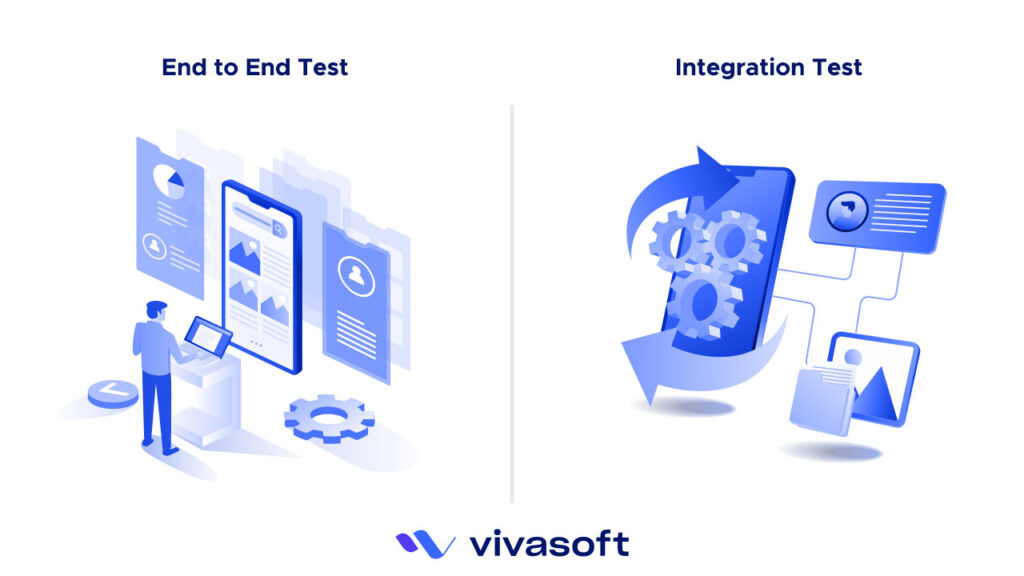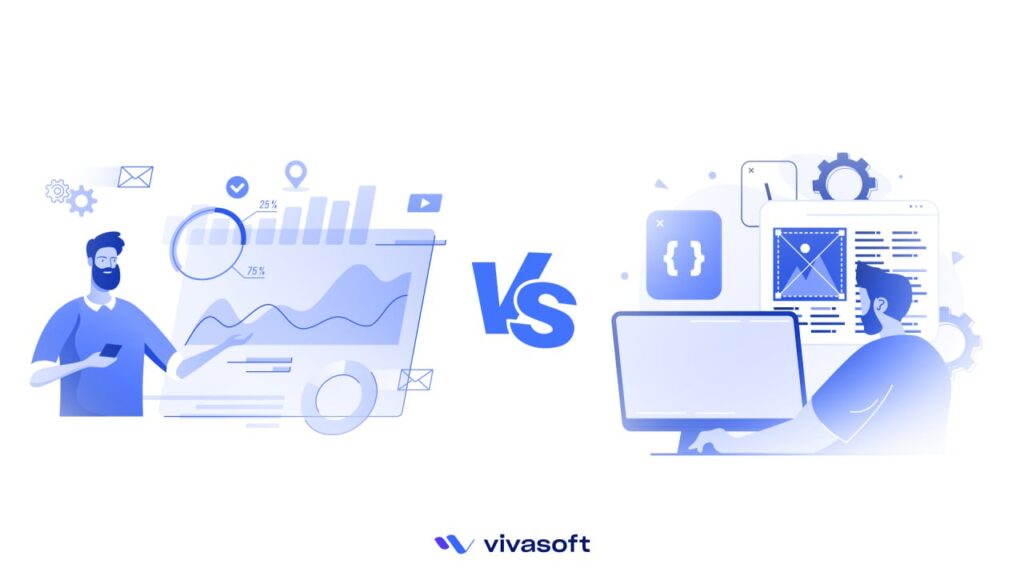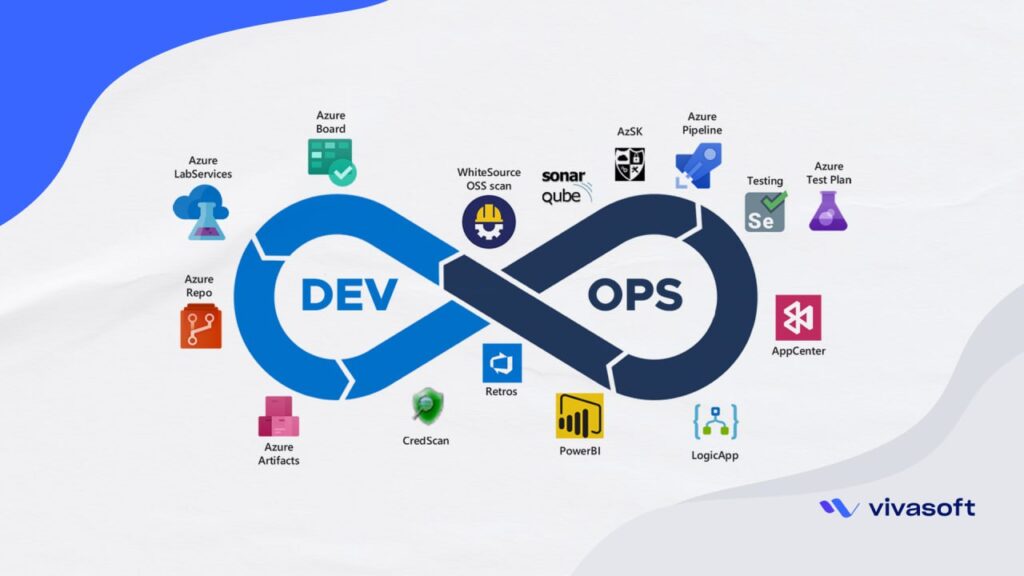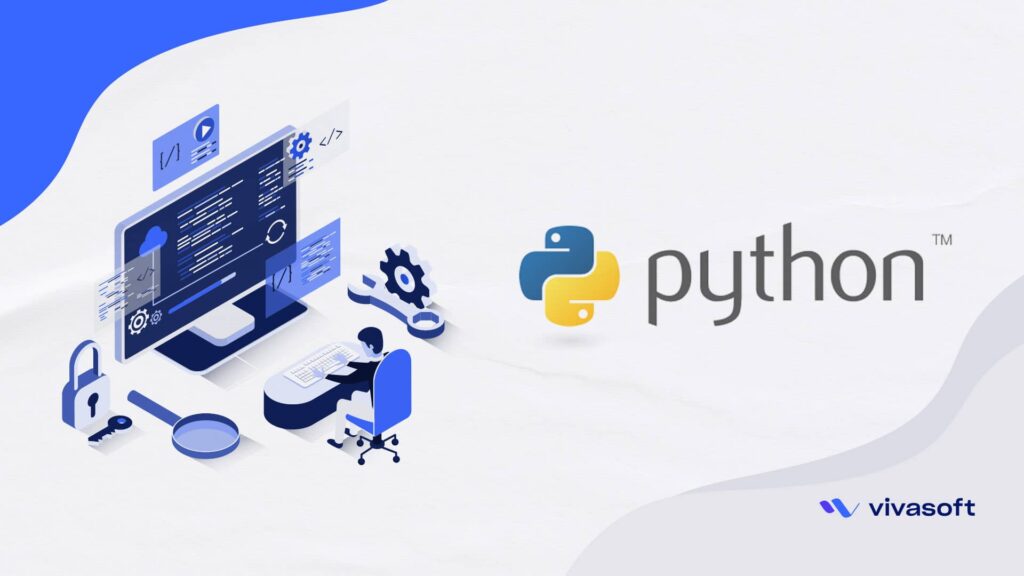DevOps approach integrates operations and development teams, speeds up QA testing to release an error-free product faster in the market.
DevOps recommends shift-left testing principles. In the Software Development Life Cycle (SDLC), devOps and QA testers are involved in creating and maintaining software from the product development to deployment.
Shift-Left Testing is imperative as it eliminates bugs and glitches once it’s released. Saving time and costs by bringing QA testing early, ensuring efficient, error-free software development in DevOps.
Key Concepts of DevOps
DevOps framework collaboration between development and operation is beneficial for resulting software delivery and agility. In organizations, these components are considered to be DNA for coding specialists.
The key components include :
- Continuous integration (CI)
- Continuous deployment (CD)
- Automation in software development
- Infrastructure as Code (IaC)
- Continuous operations
- Collaboration between operations and developers
Continuous Integration (CI)
The process involves automated builds and tests to detect integration issues early in the software development lifecycle (SDCL).
For example, consider a development team assigned a web application project. QA specialists and testers will use CI tools like Azure and Jenkins in the development phase. Analyzing each developer’s code, the tool automatically builds and runs unit tests to ensure the new code integrates seamlessly with the previously built codebase.
Continuous Deployment (CD)
Continuous Delivery (CD) is the extension of Continuous Integration CI. It goes hand in hand, one after another.
The process ensures code changes are transferred to production. Organizations use tools like Travis CI GitHub to deploy applications automatically. It reduces manual intervention, minimizes deployment errors, and accelerates the release cycle in the workflow.
Infrastructure as Code (IaC)
Infrastructure as Code involves defining and managing infrastructure using code and automation tools.
IaC is a combined effort of automation tools. For instance, it operates a Terraform file or AWS Cloud to define a cloud server, specify its size, and set up networking in the IT infrastructure.
Terraform tool automates IT infrastructure provisioning, creation, and management using Infrastructure as Code principles efficiently.
Continuous Operations
Continuous Operations focus on maintaining system health and availability.
It is beneficial to detect flaws earlier in the software development life cycle. The infrastructure ensures seamless application, recovers from failures and operates continuously without manual intervention.
Collaboration Between Operations and Developers
DevOps functions as a bridge for two separate teams. On the left side are the developers, and on the right side are QA specialists and testers.
DevOps establishes cross-functional teams where developers and operations have worked together since the beginning.
Both teams implement automation tools such as automated testing suites that developers and operations teams contribute to the main production cycle.
The collective approach is necessary for giving feedback and making changes to the loop.
Organizations should conduct training sessions to enhance mutual understanding of perspectives and workflows. Establishing a common ground for both teams is the way to go. Creating a culture of shared responsibility that enhances teamwork, accelerates project timelines, and ultimately delivers better outcomes in the production cycle.
Both teams will share views on how to manage tasks collectively and efficiently.
What is Shift-Left Testing and How Does it Differ From Traditional Approach

Shift-Left Testing practices enable QS specialists and testers to identify defects and bugs in the software development life cycle (SDCL).
Organizations allow testers to start working in the design and requirement phase in collaboration with the developers. Both teams identify and minimize risk maximization, which results in faster project delivery.
Key differences help you to get the exact meaning of shift-left testing and traditional practices.
| Shift-Left Approach | Traditional Approach |
|---|---|
| Testing takes place at the beginning of the production cycle. Attention to detail quality from phase one. | Testing is always done in the deployment phase of the production cycle. |
| A collaborative approach of continuous testing and continuous deployment. | Testing done in the water cycle and creates a feedback loop. |
| Bugs and glitches detected earlier. | Bugs and glitches detected in the last phase. |
| Test faster, test often, test early, and automate. | Lack of visibility, task duplication, and project backlogs. It is leading to cost overruns and project delays. |
| Every single code is tested. | Code only tests in the production. |
| Cost-efficient and early project deployment. | Cost overruns and project delays. |
| The DevOps team collaborates with the developer team in the planning phase. Contribute how to move in the next phase. | Team collaboration takes place at the end of the cycle. |
Role in DevOps Workflow

DevOps is crucial in collaborating development and operations for enhanced efficiency and quality assurance.
Shift-left Testing transforms how teams create and deliver software.
How do you move from performance testing to performance engineering? Can it be automated?
Continuous Integration and Continuous Deployment (CI/CD)
DevOps workflows prioritize Continuous Integration (CI) and Continuous Deployment (CD). CI automatically merges code changes into a shared repository, while CD automated code deployment to production, aligning seamlessly with Shift-Left Testing principles.
Suppose developers write code changes and automated testing processes by applying CI. Identify potential issues, providing instant feedback and enabling action into the workflows.
Process Automation
DevOps workflows leverage automation tools like Jenkins — to speed up the development process.
Automated testing integrated into the CI/CD pipeline allows for quick and efficient verification of code changes, ensuring that the software remains stable throughout its software development life cycle.
Feedback Loops for Continuous Improvement
Shift-Left Testing is incorporated into this organized process; it creates a loop of continuous improvement for both development and testing practices.
The DevOps workflow seamlessly integrates Shift-Left Testing into the entire software development lifecycle by implementing collaboration, embracing automation, and adopting continuous improvement.
DevOps does not also incorporate Shift-Left Testing principles, resulting in a more robust and efficient software development process.
Shift-Left Testing Principles

Why does Shift-Left Testing matter in the world of DevOps?
As you already know, the Shift-left approach detects bugs and glitches earlier through an integrated process. Businesses follow the principles to ensure a lasting experience for the users.
Several Reasons Why Shift-Left Testing Is Essential for DevOps
Prompt Feedback: Shift-Left Testing is like quickly checking with the code unit and sharing feedback with the code specialists. Testing early in development means preventing issues before the final code is deployed. Bugs are fixed promptly within several hours.
Early Bug Detection: Another advantage of Shift-Left Testing is the ability to detect defects earlier. Code specialists validate the codes in an automated build. It helps the DevOps team ensure the code is ready to be deployed in a staging environment.
Budget-Friendly Bug Fixes: Detecting bugs frequently saves time, money, and brainpower. There is no need for costly corrections when you’ve detected and resolved issues before the production cycle.
A Touch of Excellence: Shift-Left Testing approach ensures a quality product and meets users’ satisfaction.
Risk Reduction: Once you come through an integrated process, you may become relaxed about the shortcomings. Testing early acts as a safeguard—no need for last-minute changes.
Proven Team Collaboration: Shift-Left Testing depends on close collaboration between QA specialists and code specialists. Collaborating from the planning and requirement stage may improve teamwork excellence. As this is an ongoing process, the team finds optimal solutions for any issues.
To sum up, Shift-Left Testing principles ensure fast deployment and a more cost-effective journey from development to deployment.
How to Implement Shift Left Testing: A Guideline For Your Workflow
Implementing shift left testing in your workflow involves several key steps:
Start Testing Early
Initiating testing early involves assessing unit codes. Codes specialists integrate codes in a shared repository. This is done using a source code management tool. Then, it is followed by an automated unit test. Testing takes place from the developer’s end and is followed by the QA specialists.
For instance, you can test specific features rather than waiting for the entire web application to be fully developed. Such as user login functionality, product search feature, or checkout process before deployment.
Test-driven development (TDD)
Test-driven development (TDD) is a software development approach where developers write tests before creating the actual code. The process involves creating small, automated tests defining the written code’s functionality. Developers then write the unit code to pass those tests.
Implement the TDD approach in the DevOps workflow. The systematic approach ensures that the code meets specified requirements per the planning.
TDD acts as a guide, influencing the requirement, planning, development, build, test, and deployment process. You may experience how this approach excels in building an error-free product.
Behavior-driven development (BDD)
BDD is another integration technique for testing purposes. It involves defining how the software should behave under different scenarios or user interactions. I also define a software flow chart’s expected actions, functionalities, or responses in response to specific inputs.
If you are a tester, try contributing to shaping and clarifying expected behaviors to the developers.
Pair testing
Collaboration between testers and developers is important in pair testing. They work closely together, execute tests, discuss results, and make necessary adjustments. Pair testing means the unit codes are tested on the developer and DevOps end. This collaborative effort ensures that testing is integrated seamlessly into the development process.
Automate as much as possible
Automation is crucial in Shift-Left Testing. Focus on creating automated tests for multiple purposes.
For instance, implement unit tests to check the calculations in a financial module, API tests, and simple UI tests to ensure a seamless user experience. This automation allows the team to identify and address issues swiftly.
Provide fast feedback
Shift Left Testing emphasizes prompt feedback. Facebook and Google are great examples. You may see how frequently and promptly they make changes to the product.
For example, if an automated test for payment processing fails or you discover a usability issue during manual testing, Report it to the development end immediately.
Consider where an issue with the payment gateway is detected within a day of its introduction – addressing it promptly can prevent potential financial losses and enhance overall system reliability.
Collaborate closely with developers
Successful Shift-Left Testing involves close collaboration with developers.
Suppose you regularly collaborate with developers to follow the requirements and the decisions taken in the team meeting. Frequent interaction takes place before they start coding. It may take 50 sittings before the deployment.
Remember that you are going through a continuous integration and delivery process until the deployment.
This collaborative approach ensures that the specialists build and validate the software. Reduces the probability of further defects rather than arising later in the deployment cycle.
Finally, every product comes with security issues. Dynamic Application Security Testing (DAST) is a method where applications are tested while running to check for security issues.
Misconceptions and Solutions
You may have encountered numerous things that could be improved about Shift-Left Testing.
Here are the most common perceived misconceptions:
Specialized skills
Shift-Left Testing doesn’t require specialized skills. In the agile approach, training is beneficial but optional. Regardless of technical expertise, the team can adopt Shift Left Testing with continuous practice.
Shift-Left Testing consumes time and burns money
It saves time once the product is ready to be released. The fourth procedure consumes much time rather than resolving the issues with a continuous integration and delivery method. Identifying and fixing bugs early is more efficient than waiting for staging stages.
One study found that detecting issues in the early development process may cost you, but detecting bugs in the deployment stage may outweigh the initial budget. It will cost you more once it is transferred into the production cycle.
Bugs are minor issues
Bugs matter to ensure software quality. Addressing minor issues early may prevent complexities of the product release.
Shift Left Testing requires process adjustments
Workflow adjustments are necessary to some extent. Enhanced collaboration between the developer and operation team, shorter feedback loops, and adjustments with other teams make Shift-Left testing easy to implement.
Final Thoughts
DevOps recommends Shift-Left Testing to integrate development and operations, accelerating error-free software releases. Vivasoft goes through practices like TDD and BDD; it detects defects early, saving time and costs. The team is continuously testing the changes in code and deploying them to the production cycle. Automation tools, continuous integration, and continuous delivery ensure ongoing improvement, achieving faster, cost-effective, and high-quality software deployment and ensuring faster product release.
| Shift-Left Approach | Traditional Approach |
|---|---|
| Testing takes place at the beginning of the production cycle. Attention to detail quality from phase one. | Testing is always done in the deployment phase of the production cycle. |
| A collaborative approach of continuous testing and continuous deployment. | Testing done in the water cycle and creates a feedback loop. |
| Bugs and glitches detected earlier. | Bugs and glitches detected in the last phase. |
| Test faster, test often, test early, and automate. | Lack of visibility, task duplication, and project backlogs. It is leading to cost overruns and project delays. |
| Every single code is tested. | Code only tests in the production. |
| Cost-efficient and early project deployment. | Cost overruns and project delays. |
| The DevOps team collaborates with the developer team in the planning phase. Contribute how to move in the next phase. | Team collaboration takes place at the end of the cycle. |
Role in DevOps Workflow

DevOps is crucial in collaborating development and operations for enhanced efficiency and quality assurance.
Shift-left Testing transforms how teams create and deliver software.
How do you move from performance testing to performance engineering? Can it be automated?
Continuous Integration and Continuous Deployment (CI/CD)
DevOps workflows prioritize Continuous Integration (CI) and Continuous Deployment (CD). CI automatically merges code changes into a shared repository, while CD automated code deployment to production, aligning seamlessly with Shift-Left Testing principles.
Suppose developers write code changes and automated testing processes by applying CI. Identify potential issues, providing instant feedback and enabling action into the workflows.
Process Automation
DevOps workflows leverage automation tools like Jenkins — to speed up the development process.
Automated testing integrated into the CI/CD pipeline allows for quick and efficient verification of code changes, ensuring that the software remains stable throughout its software development life cycle.
Feedback Loops for Continuous Improvement
Shift-Left Testing is incorporated into this organized process; it creates a loop of continuous improvement for both development and testing practices.
The DevOps workflow seamlessly integrates Shift-Left Testing into the entire software development lifecycle by implementing collaboration, embracing automation, and adopting continuous improvement.
DevOps does not also incorporate Shift-Left Testing principles, resulting in a more robust and efficient software development process.
Shift-Left Testing Principles

Why does Shift-Left Testing matter in the world of DevOps?
As you already know, the Shift-left approach detects bugs and glitches earlier through an integrated process. Businesses follow the principles to ensure a lasting experience for the users.
Several Reasons Why Shift-Left Testing Is Essential for DevOps
Prompt Feedback: Shift-Left Testing is like quickly checking with the code unit and sharing feedback with the code specialists. Testing early in development means preventing issues before the final code is deployed. Bugs are fixed promptly within several hours.
Early Bug Detection: Another advantage of Shift-Left Testing is the ability to detect defects earlier. Code specialists validate the codes in an automated build. It helps the DevOps team ensure the code is ready to be deployed in a staging environment.
Budget-Friendly Bug Fixes: Detecting bugs frequently saves time, money, and brainpower. There is no need for costly corrections when you’ve detected and resolved issues before the production cycle.
A Touch of Excellence: Shift-Left Testing approach ensures a quality product and meets users’ satisfaction.
Risk Reduction: Once you come through an integrated process, you may become relaxed about the shortcomings. Testing early acts as a safeguard—no need for last-minute changes.
Proven Team Collaboration: Shift-Left Testing depends on close collaboration between QA specialists and code specialists. Collaborating from the planning and requirement stage may improve teamwork excellence. As this is an ongoing process, the team finds optimal solutions for any issues.
To sum up, Shift-Left Testing principles ensure fast deployment and a more cost-effective journey from development to deployment.
How to Implement Shift Left Testing: A Guideline For Your Workflow
Implementing shift left testing in your workflow involves several key steps:
Start Testing Early
Initiating testing early involves assessing unit codes. Codes specialists integrate codes in a shared repository. This is done using a source code management tool. Then, it is followed by an automated unit test. Testing takes place from the developer’s end and is followed by the QA specialists.
For instance, you can test specific features rather than waiting for the entire web application to be fully developed. Such as user login functionality, product search feature, or checkout process before deployment.
Test-driven development (TDD)
Test-driven development (TDD) is a software development approach where developers write tests before creating the actual code. The process involves creating small, automated tests defining the written code’s functionality. Developers then write the unit code to pass those tests.
Implement the TDD approach in the DevOps workflow. The systematic approach ensures that the code meets specified requirements per the planning.
TDD acts as a guide, influencing the requirement, planning, development, build, test, and deployment process. You may experience how this approach excels in building an error-free product.
Behavior-driven development (BDD)
BDD is another integration technique for testing purposes. It involves defining how the software should behave under different scenarios or user interactions. I also define a software flow chart’s expected actions, functionalities, or responses in response to specific inputs.
If you are a tester, try contributing to shaping and clarifying expected behaviors to the developers.
Pair testing
Collaboration between testers and developers is important in pair testing. They work closely together, execute tests, discuss results, and make necessary adjustments. Pair testing means the unit codes are tested on the developer and DevOps end. This collaborative effort ensures that testing is integrated seamlessly into the development process.
Automate as much as possible
Automation is crucial in Shift-Left Testing. Focus on creating automated tests for multiple purposes.
For instance, implement unit tests to check the calculations in a financial module, API tests, and simple UI tests to ensure a seamless user experience. This automation allows the team to identify and address issues swiftly.
Provide fast feedback
Shift Left Testing emphasizes prompt feedback. Facebook and Google are great examples. You may see how frequently and promptly they make changes to the product.
For example, if an automated test for payment processing fails or you discover a usability issue during manual testing, Report it to the development end immediately.
Consider where an issue with the payment gateway is detected within a day of its introduction – addressing it promptly can prevent potential financial losses and enhance overall system reliability.
Collaborate closely with developers
Successful Shift-Left Testing involves close collaboration with developers.
Suppose you regularly collaborate with developers to follow the requirements and the decisions taken in the team meeting. Frequent interaction takes place before they start coding. It may take 50 sittings before the deployment.
Remember that you are going through a continuous integration and delivery process until the deployment.
This collaborative approach ensures that the specialists build and validate the software. Reduces the probability of further defects rather than arising later in the deployment cycle.
Finally, every product comes with security issues. Dynamic Application Security Testing (DAST) is a method where applications are tested while running to check for security issues.
Misconceptions and Solutions
You may have encountered numerous things that could be improved about Shift-Left Testing.
Here are the most common perceived misconceptions:
Specialized skills
Shift-Left Testing doesn’t require specialized skills. In the agile approach, training is beneficial but optional. Regardless of technical expertise, the team can adopt Shift Left Testing with continuous practice.
Shift-Left Testing consumes time and burns money
It saves time once the product is ready to be released. The fourth procedure consumes much time rather than resolving the issues with a continuous integration and delivery method. Identifying and fixing bugs early is more efficient than waiting for staging stages.
One study found that detecting issues in the early development process may cost you, but detecting bugs in the deployment stage may outweigh the initial budget. It will cost you more once it is transferred into the production cycle.
Bugs are minor issues
Bugs matter to ensure software quality. Addressing minor issues early may prevent complexities of the product release.
Shift Left Testing requires process adjustments
Workflow adjustments are necessary to some extent. Enhanced collaboration between the developer and operation team, shorter feedback loops, and adjustments with other teams make Shift-Left testing easy to implement.
Final Thoughts
DevOps recommends Shift-Left Testing to integrate development and operations, accelerating error-free software releases. Vivasoft goes through practices like TDD and BDD; it detects defects early, saving time and costs. The team is continuously testing the changes in code and deploying them to the production cycle. Automation tools, continuous integration, and continuous delivery ensure ongoing improvement, achieving faster, cost-effective, and high-quality software deployment and ensuring faster product release.

















